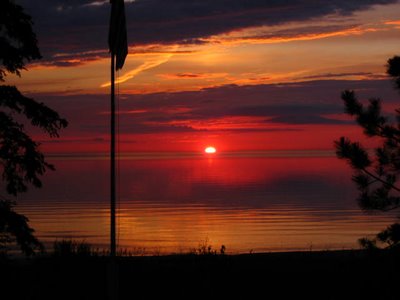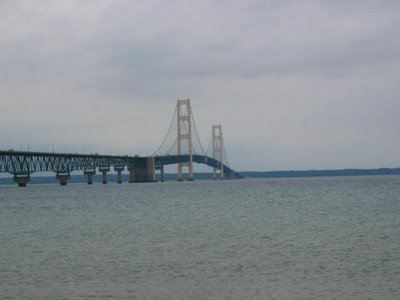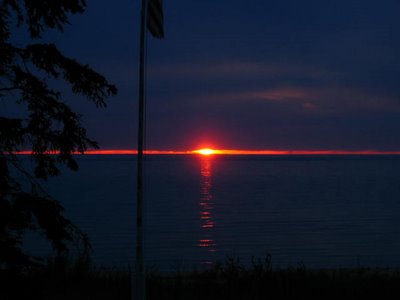The Safety of Objects
Home at last! And so WagnerQuest 06 reaches its end, as indeed all things must. As a final blog fling, I thought it would be fun to go through my prop list: which items were of most value to me on this expedition, the ones that left Seattle with me two months ago and never made it back, and the ones that I picked up along the way. Late last night, unpacking after yet another long and laborious trek-ordeal (drive six hours, Mackinaw to Detroit; fly two hours to Denver and three to Seattle, shock of “Hey! I remember this place!” and running into everbody in the community on a gorgeous Seattle summer night), the items I dealt with included:
DESTROYED. My Dell Latitude LAPTOP, over three years old now, the system board departed this world one morning when I was in London (I’m told we’ll be able to retrieve the data, including all those pictures that never made it to the blog). My much-loved Tumi 2 BACKPACK, which has accompanied me for many years over much of this world; the zippers are hopeless, the fabric is torn in many places, and all the ergonomic stuffing is falling out. My L. L. Bean GARMENT BAG of many years and many trips, which exploded on a train in Switzerland—I learned too late that it was never intended to function as a bookbag as well as suitcase as well as garment bag. My GOGGLES ripped a couple days ago; easy come, easy go. And my 4 Megapixel Canon DIGITAL CAMERA went for a swim in Lake Michigan a few weeks ago as someone was trying to take a sunset photo of me swimming for this very blog.
My CELL PHONE is the only electronic device that survived the trip, although it’s been acting very strange since I got home; perhaps it committed suicide, in order to join its friends the camera and computer.
CAME HOME SAFE. KEYS, WALLET, CREDIT and DEBIT CARDS, PASSPORT, CHECKBOOK, and big bag full of world electronic ADAPTORS. Like an idiot I left my 3-to 2 prong American power adaptor here in Seattle, after carefully re-wiring everything in my apartment so I could take it along; I bought a new one in Denmark which allowed me several good weeks of recharged computer/camera/phone batteries. My CLOTHES all made it back, although it was odd to pack for two different trips: in northern Michigan I basically only wore a SWIMSUIT all day every day, and thus didn’t need my opera-going SUITS or the HIP BOLLYWOOD SHIRT I picked up in London.
NEW ACQUISITIONS. In addition to said HIP BOLLYWOOD SHIRT, I picked up a souvenir DRINKING HORN at Roskilde’s Viking Ship Museum, which my nephew kept using to drink his lemonade; the beautiful season PROGRAM BOOK for the Glyndebourne festival; a Reclam copy of E. T. A. Hoffmann’s GOLDNE TOPF auf Deutsch, a lovely little Italian book with pictures of CARNEVALE IN VENEZIA, all about commedia dell’arte; and a really beautiful art monograph by Kristian Davies, THE ORIENTALISTS, featuring lively prose and incredible reproductions of the great nineteenth-century European academic painters who were obsessed with ‘Oriental’ subjects (camel caravans, mideast landscapes, harems, baths, slave markets, etc.). I also picked up and distributed at various points along the way a gift or two, including such items as a jug of MEAD, a Venetian CARNIVAL MASK, and lots of Mackinaw FUDGE.
The really unexpected item I bring home is a gift my sister-in-law gave me a few days ago, a Burt’s Bees “5 STEPS TO SOFTER FEET" PACKAGE with a pumice stone, coconut foot cream that’s slicker than 10W-40, and little black socks with bees on them. The fact of the matter is, my feet ended up in pretty bad shape, after perhaps too much walking around Europe and probably too long barefoot in the lake and the sun in northern Michigan. Megan’s maternal instincts kicked in when she noticed that my feet were fast turning into dragon claws, and I was surprised to find that the Burt’s Bees treatment, so far, is working pretty well.
THE LIBRARY. The stuff that either accompanied me across Europe or got mailed ahead of time to northern Michigan: BOOKS on Wagner (his autobiography, Millington’s Wagner Compendium, Spencer’s Wagner Remembered, and biographies by Sabor and Gutman; Wagner’s source texts for the Ring (the Elder Edda, in the Auden and Terry translations, the Younger Edda, the Volsunga and Thidreks Sagas, and the Nibelungenlied; and don’t forget, if you’re looking at this material, the great books Kingdom on the Rhine by Nancy Benvenga and Richard Wagner and the Nibelungs by Elizabeth Magee); several books on screenwriting, the most useful of which I found to be McKee’s Story; To Have and Have Not by Ernest Hemmingway; Hollywood, by Gore Vidal; Collected Stories by David Leavitt; Erotic Poetry by Goethe (facing-page edition with translations by David Luke); and Struggle for a Vast Future (my brother Aaron Sheehan-Dean’s new book on the American Civil War, which I finished while ‘Up North’). In terms of travel guidebooks, I profited from publications by Lonely Planet, Let’s Go, Time Out, Discovery Channel, and Teach Yourself Danish, although I have a habit of lightening my load by leaving each book in the relevant country. CDs included Midsummer Night’s Dream music by Mendelssohn and Britten; the deluxe 3-disc edition of Howard Shore’s Fellowship of the Ring music; the gorgeous Silk Road Ensemble discs recently pushed through by Yo-Yo Ma; a disc by Nickel Creek, and another by Air; the soundtrack to Amélie and Peter Gabriel’s Passion; masses by Ockeghem and motets by Machaut; Britten’s Phaedre and Billy Budd; and an historic recording of Ralph Vaughan Williams conducting his Wasps overture and Old King Cole ballet, as well as an abridged 1924 recording of his great opera Hugh the Drover. And of course, there were lots of Wagner discs. DVDs that came on this trip included the Palmer Wagner movie; Palmer’s film of Britten’s Death in Venice; several Shakespeare movies (including Olivier’s Hamlet, Al Pacino as Shylock in Merchant of Venice, and Kevin Kline as Bottom in Midsummer Night’s Dream); The Vikings; The Big Lebowski; The Thin Red Line; The Blues Brothers; Millions; some Harry Potter and Indiana Jones; and (special favorite of my niece and nephew) the Powell/Pressburger film of Tales of Hoffmann.
The trip itself is finite, but these entertaining and reassuring objects exist without end. So which is more alive? Or have I forgotten the most important ‘object’ on this search, the holy grail at the end of this WagnerQuest—the huge pile of index cards with notes, the two full spiral notebooks, and the 40-page emails with outlines, treatments, and synopses of the screenplay to MONSTER GOD?









